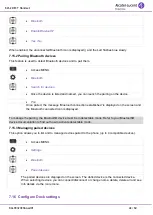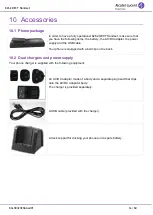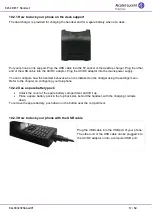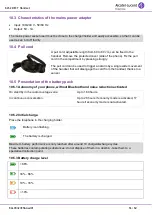
Al
cat
el
-Lucent
8
2
6
2
D
E
C
T
Ha
nds
et
Quick gui
de
w
w
w
.al
-e
nte
rpr
is
e.co
m
Related Documentation
-
Other languages for these Safety and Regulatory Instructions and User Documentation are available at the following Web site :
. copyright © ALE International 2016 - QuickGuide
Status icons
The status icons are displayed on the welcome screen and
indicate the status of the telephone.
Battery charge level (
>
>
>
).
In charge (flashing icon).
Received messages,callback request and unanswered
calls.
Indicates a pending calendar notification.
Appointment programmed.
Call diversion activated.
Vibrate mode active.
Ringer active.
Ringer disabled.
Radio reception quality - Normal Mode.
Radio reception quality - 50 mW power.
Loudspeaker on (in conversation).
Mute on (in conversation).
Economy mode activated and used (green).
Economy mode activated (gray).
Alarm active icon.
Bluetooth enabled.
Bluetooth connected to a device.
Bluetooth audio active with a connected device.
You can obtain details on the status icons from the
tooltips that appear on the welcome screen when you
use the navigator:
MENU icons
The MENU is accessible from the welcome screen by pressing the
OK key. It provides access to all the functions available on your
system. All icons are described in their unselected state. When
selected, the icons are displayed in purple.
Directories:
Manage your personal directory and access the company
directory.
Redial.
Call back the last number dialed.
Divert your calls to another number.
Consult and send voice and text messages.
Access the call log.
Answer a call intended for another telephone.
Program a call-back time.
Lock/unlock the set.
Access the services configuration of the handset
(associate, overflow, password, name, number, etc.).
Access the general settings of the phone (key sound,
economy mode, charger warning, programming of F1 and
F2 keys, etc.).
Access the calendar.
Alarm settings menu.
Access the alarm acknowledgment services.
Call icons
Making a call.
Receiving a call.
Call on hold.
Accessing the directories.
Transferring a call.
Switching to DTMF signals.
Setting up a conference.
Forwarding your calls to your voice message service.
Putting on common hold.
Parking an external communication.
Additional options (Features depending on the system).
Features
Answered incoming calls.
Redialing (long press).
Send the call.
Switching between two outgoing calls.
Ignore call.
End the call.
Calling from your personal directory (PersSpDial).
Calling your caller by name (company directory).
Programming your personal directory (PersSpDial).
Call from call log (All incoming, outgoing, missed or
unanswered calls are displayed in the call log).
Consulting missed calls.
Consulting text messages.
Sending text messages.
Consulting your voice mailbox.
Sending a recorded message to a number or a
distribution list.
Divert your calls to another number.
Diverting calls to your voice mailbox.
Different types of diversions.
Do not disturb.
Cancelling all forwards.
Modifying your personal code.
Choice of language.
Choose the tune.
Adjusting the ringer volume.
Access the ringer and vibrate adjustment feature.
Programming an appointment reminder.
Locking features on your terminal.
Access the handset settings menu (Device info,
Coverage warning, Security
, …).

































